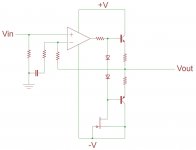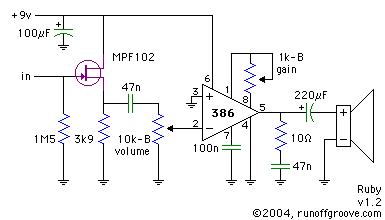Hello!
I am trying to build an amp for my electric guitar.
Why cant I just use one op amp to amplify the sound? I am using the typical inverting configuration, when I play the guitar I see the signal in my oscillo being amplified nicely and going from +6 to -6.... but when I connect a speaker to the output and I can hardly hear some sound and very distorted...
What am I missing out? Why isn't is working?
Thanks!!
I am trying to build an amp for my electric guitar.
Why cant I just use one op amp to amplify the sound? I am using the typical inverting configuration, when I play the guitar I see the signal in my oscillo being amplified nicely and going from +6 to -6.... but when I connect a speaker to the output and I can hardly hear some sound and very distorted...
What am I missing out? Why isn't is working?
Thanks!!
The speaker is a heavy load. Impedance 4/8 Ohm.
It takes a bit more than LM741 to drive drive your speakers.
For example LM386
LM386 - Low Voltage Audio Power Amplifier
It takes a bit more than LM741 to drive drive your speakers.
For example LM386
LM386 - Low Voltage Audio Power Amplifier
BTW The whole purpose of building this amplifier is to understand a bit how amps work.
I just read that the typical power this op amp can deliver is 60 mW... So to drive some cheapo headphones how much power would I need? Isn't that enough?
Feel free to point me to some docs you believe I should read, I searched myself but didn't find much..
Thanks!
edit: BTW I just read the 328 can deliver up to 1W....
I just read that the typical power this op amp can deliver is 60 mW... So to drive some cheapo headphones how much power would I need? Isn't that enough?
Feel free to point me to some docs you believe I should read, I searched myself but didn't find much..
Thanks!
edit: BTW I just read the 328 can deliver up to 1W....
Last edited:
Whether it's headphones or speakers you need to do the math to determine the required current and voltage drive based on the desired output SPL, driver efficiency, and expected range of load impedances. This is straightforward Ohm's law and dB efficiency stuff.So to drive some cheapo headphones how much power would I need?
As a rule of thumb typical speaker listening powers for home audio usually fall within a couple orders of magnitude of 10mW and typical headphone powers more like a few uW. In most 'phone applications that means you're looking at tens of uA to a few mA peak. Just about any op amp and supply are sufficient for that. The LME49720 is a good starting point.
Hello!
Why cant I just use one op amp to amplify the sound? I am using the typical inverting configuration, when I play the guitar I see the signal in my oscillo being amplified nicely and going from +6 to -6.... but when I connect a speaker to the output and I can hardly hear some sound and very distorted...
What am I missing out? Why isn't is working?
Thanks!!
A speaker is around 8 ohms, the output impedance of the 741 is about 100ohms so all the power is being lost inside the 741.
I have succesfully driven headphones from op-amps with resistors on the output but obviously not very loud. I used an op-amp to drive a disco cueing headphones, right deck went to right ear and left deck to left ear. Despite 225WRMS of disco sound I could still cue using the headphones.
For a 8 ohm speaker you need at least a few watts of power, you can use a chip amp or a discrete amp for this. Loads of circuits on DIYAUDIO.
You can easily buy a module off ebay for a few pounds.
A speaker is around 8 ohms, the output impedance of the 741 is about 100ohms so all the power is being lost inside the 741.
2.2Wrms @8R (6Vp) is 750mAp. The circuit in post 7 simply adds a current amplifying stage to lower the 100R output impedance so it will drive a speaker. Use 47-100R for the base resistor and maybe 0.47R for the emitter resistors. You could use TO-126 transistors for the outputs or rather multiple paralelled small signal devices like 2N4401/4403 just make sure each transistor has its own emitter and base resistors. Increase the emitter resistors as well, for example, 3R if you use 6 pairs. J-fet can be any device, Idss maybe 2-10mA. Mount the diodes against the BJTs. I cannot think of a cheaper solution since those transistors cost only pennies a piece.
I tried to emulate what this guy did... he build a guitar amplifier by using 4 op amps each with a gain of x10.
Op Amp Guitar Amplifier - SparkFun Electronics
this is the circuit:
http://www.sparkfun.com/images/tutorials/GuitarAmp/GuitarAmp.pdf
the operational he used is this one:
http://www.ti.com/lit/ds/symlink/lmv324.pdf
Why does it work then? Because the output impedance of the op amp he is using is lower?
My mistake is that I tried to do the same with a 741
Does using 4 op amps with a gain of 10 help to drive the speaker? Could he just achieved the same using one op amp and choosing the resistors if his inv-amp so he gets x10000?
Thanks!!!
Op Amp Guitar Amplifier - SparkFun Electronics
this is the circuit:
http://www.sparkfun.com/images/tutorials/GuitarAmp/GuitarAmp.pdf
the operational he used is this one:
http://www.ti.com/lit/ds/symlink/lmv324.pdf
Why does it work then? Because the output impedance of the op amp he is using is lower?
My mistake is that I tried to do the same with a 741
Does using 4 op amps with a gain of 10 help to drive the speaker? Could he just achieved the same using one op amp and choosing the resistors if his inv-amp so he gets x10000?
Thanks!!!
It is simply a non-inverting op-amp circuit that includes the output follower BJTs within the FB loop. The output of the op-amp is conducting DC current through the diodes and through the J-fet. The J-fet used in this way creates a constant current source. So whatever the Idss of the J-fet is, check a datasheet for whatever one you have on hand, that current will be conducted from the op-amp output pin. This sets up a bias voltage across the diodes to bias the BE juntion of the BJT's, two forward PN junction drops. The emitter resistors limit current and add stibility to the bias. The diodes and BJTs should be in contact so they share the same temperature, and this also adds stability to the bias. This is class AB, where both devices conduct a small current but the NPN transistor drives the positive half of the waveform and the PNP drives the negative. Another option, and perhaps simpler, would be to use class A, but this would require dissapating ~10W of heat assuming a +/-6V supply.
Opamps
Why not Google the Application Notes from the relevant manufacturer?
Also, you can go to an industrial supplier website like Mouser, Digi-key, Newark, Farnell etc.and download datasheets there for the particular type available, then search for the ANs you see there. These ANs can be for generic types which will be fine for understanding of the the quick and simple sort and get you up and going, assuming you already have some understanding of electronics.
If you need the A-Z of electronics and how op-amp circuits (or rather, amplifiers in general) work, you really need to start at the fundamentals with a basic textbook. Set aside more than a few evenings for this, since you won't learn much in just a few forum posts or reading shallow descriptions on the web.
A comprehensive but very accessible text is "Op amps for everyone" by Carter & Mancini (TI). There are plenty more and I think there is even an "Op amps for dummies" title.
Why not Google the Application Notes from the relevant manufacturer?
Also, you can go to an industrial supplier website like Mouser, Digi-key, Newark, Farnell etc.and download datasheets there for the particular type available, then search for the ANs you see there. These ANs can be for generic types which will be fine for understanding of the the quick and simple sort and get you up and going, assuming you already have some understanding of electronics.
If you need the A-Z of electronics and how op-amp circuits (or rather, amplifiers in general) work, you really need to start at the fundamentals with a basic textbook. Set aside more than a few evenings for this, since you won't learn much in just a few forum posts or reading shallow descriptions on the web.
A comprehensive but very accessible text is "Op amps for everyone" by Carter & Mancini (TI). There are plenty more and I think there is even an "Op amps for dummies" title.
thanks for the pointers guys! I've been using op amps to amplify small signals and feed them into a scope but never drove a speaker, this was my first naive attempt.
So the 741 is bad because of its high output impedance and low output current... if I stack one 741 on top of another wouldn't I get double output current and half output impedance?
gaetan: So what makes an opamp a good candidate for audio? Just output current and low output impedance?
So the 741 is bad because of its high output impedance and low output current... if I stack one 741 on top of another wouldn't I get double output current and half output impedance?
gaetan: So what makes an opamp a good candidate for audio? Just output current and low output impedance?
- Status
- This old topic is closed. If you want to reopen this topic, contact a moderator using the "Report Post" button.
- Home
- Amplifiers
- Solid State
- LM741 :-)

